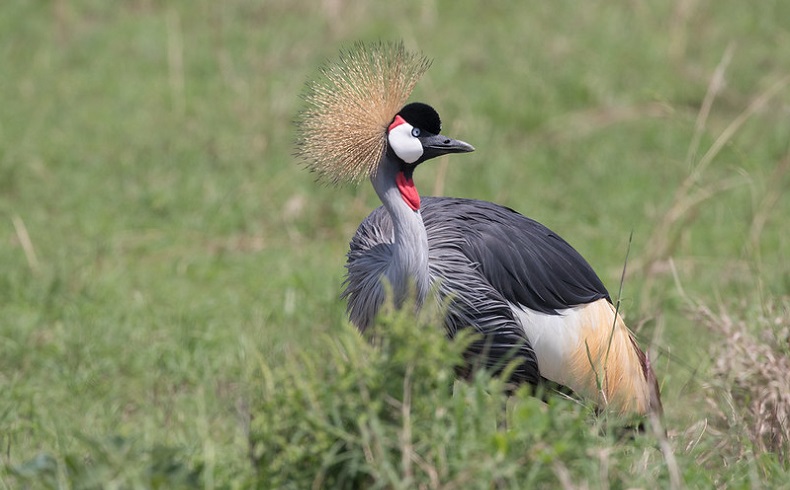Scientifically known as Balearica regulorum is a bird in the crane family is found in Eastern and Southern Africa, and is the national bird of Uganda. Commonly known as Ngaali, the grey crowned crane symbolizes beauty, wealth longevity and good fortune. Now more than ever these birds need our help.
There are two subspecies. B. r. regulorum (South African crowned crane), which breeds from Angola south to South Africa and The East African B. r. gibbericeps which occurs in the East of the Democratic Republic of the Congo and in Uganda, Kenya to Eastern South Africa.
The grey crowned crane is about 3.3 ft tall, weighs 3.5 kg and has a wingspan of 2 m. It has a larger area of bare red facial skin above the white patch than the smaller nominate species. Males and females look very much the same, although females may be slightly smaller.

Grey crowned cranes use a mixture of wetland and grassland habitats, nesting in marshes, cultivated lands and grassy flatlands near rivers and lakes in Uganda and Kenya and as far as South Africa, tall wetland vegetation where their chicks can be concealed from view. This animal does not have set migration patterns. Birds nearer the tropics are typically sedentary and flocks of 30-150 birds are not uncommon.
The cranes as a family consume a wide range of food, ranging from animal to plant matter. When feeding on land they consume seeds, leaves, nuts and corns, berries, fruit, insects, worms, snails, small reptiles. In wetlands they consume frogs, worms, small fish, eggs of aquatic animals, roots, rhizomes, tubers and other parts of emergent plants.
The exact composition of the diet varies by location, season and availability. They spend their entire day looking for food and at night, the crowned crane spends its time in the trees sleeping and resting.
Grey crowned cranes breeding season is around the rains, although the effect varies geographically. In East Africa the species breeds year-round, but most frequently during the drier periods.
During the breeding season it involves dancing, bowing, and jumping, it makes a booming call which involves inflation of the red gular sac, makes a honking sound quite different from the trumpeting of other crane species. Both sexes dance and immature birds join the adults dancing as an integral part of courtship.
This pair of cranes construct a large nest, a platform of grass and other plants in tall wetland vegetation. They lay a clutch of 2-5 glossy, dirty-white eggs which are incubated by both sexes for 28–31 days. Chicks are nidifugous, run as soon as they hatch, and fledge in 56–100 days.

Uganda plays host to about 28% of the global Grey Crowned Crane population. These Cranes are usually seen as indicators of environmental health.
In 2012 it was up listed from vulnerable to endangered by the IUCN due to its grassland and wetland habitats which are under pressure from drainage, overgrazing and pollution from pesticides, and in recent decades its range and population have decreased sharply.
According to statistics from Nature Uganda and the Ministry of Tourism and Wildlife only about 10,000 to 20,000 gray crowned cranes are left in Uganda, compared with an estimated 100,000 four decades ago,
The grey crowned crane is considered sacred by many people and community education projects are helping to focus attention on the need to conserve wetlands habitats and develop sustainable alternatives to over-exploitation.

